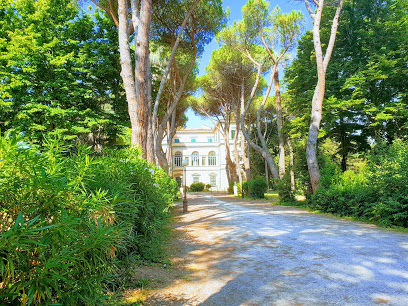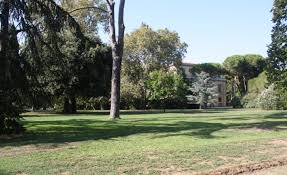It is located in Livorno in Viale della Liberta, 30. It is the headquarters of the Library of La Peronica.
History
The villa of medical origin may have been born by the will of Ferdinando de Medici as a dwelling outside the cities. After a series of changes in ownership, Bernardo Fabrici purchased it in 1881 from Mr. Tommaso Lloyd. The new owner expanded and converted it according to the project of architect Vincenzo Micheli, who also took care of the design of the garden.
Access to the property was originally through the grand entrance of Via Roma, surrounded by stables and quarters of servants, then by the entrances of Piazza della Barrera Maremana (now known as Piazza Matteotti) and Viale della Liberta, with their gates, surmounted by ornate marble vases officially presented to The villa. The lush streets crossed and surrounded by flowering meadows where the gardens were maintained, which took care of the greenhouse and nursery. Current gems include pine, oak, lemon, plane trees, palm, magnolia, eucalyptus, cedar, ficus and cypress.
A large racer and a small theater, with a nearby skating rink, were built for family entertainment. The garden was decorated with statues and chest to honor distinguished figures while remembering the most important moments in history.
In 1936, Fabbricotti was forced to sell the property to the municipality of Livorno: the villa then included two farm houses, a high water storage tower (demolition in the 1960s) with related accessories and a vast garden, for an extension of about 27 hectares, then it was significantly reduced to make room For the new surrounding area (from the old park only, access roads remain only (via the Academia Labronica from the east, Viale di Pini from the south, via Bartolina from the north) .The building was the headquarters of the German command, then the American building, suffering severe damage. It is home to the Labronica Library.
Describe
The villa deals with Renaissance architecture topics and refers to the design of the nearby Villa Membele, also designed by Vincenzo Michele. The exterior features some large circular windows made of Sri Lankan that illuminate the curtain wall, while the interior is detailed around a huge double sloped staircase.
On the first floor, there is a sculptural mother's teacher, by Paolo Emilio Demi: the plaster model was displayed in 1836 at the Academy of Fine Arts in Florence and by 1846, the work was carved in marble, although it was not completed in some parts. It was first housed in Soccorso Church and in 1865 it was moved to Asilo Grabau; in 1950, after being equipped with a new pedestal, it was transferred to Villa Fabbricotti.
Music Genie by Giovanni Baganucci
Moreover, in the villa garden there are many sculptures, such as the statue by Giovanni Baganucci and the monument of Alfredo Jerry, by Antonio Finchigira. From the ruined Palazzo Balbiani, located in Via Grande, some busts come from the Grand Dukes of Tuscany, which once adorned the facade of the same building. Here, for more than half a century, the statue of Giovanni Fattori, originally rose between Piazza della Repubblica and the city cistern: it was built in 1925 by Valmor Gimjiani, in the post-war period, was moved to the villa garden, to return to the site. It originated only in the summer of 2008. In the same year work began to move some of the marble to the original site which, before World War II, adorned the Armenian Church of San Gregorio Illuminator, whose remains were largely demolished in the 1950s. Only, and yet, there are still many other pieces of marble and statues found in the villa garden. In the Green Zone there is also a fountain for Luigi Brizzolara, most of which are damaged, coming from the demolished villa Attias. There is also a statue of businessman Gustavo Coridi, Vincenzo Siri, coming from the insecure Church of St. Eduardo.
The last statue inscribed in the garden is a bust of Mario Borghiotti, a key man in the arts of Leghorn, created by painter and sculptor Massimo Lome, niece of Giovanni, a housewife with a bust inside the villa.




